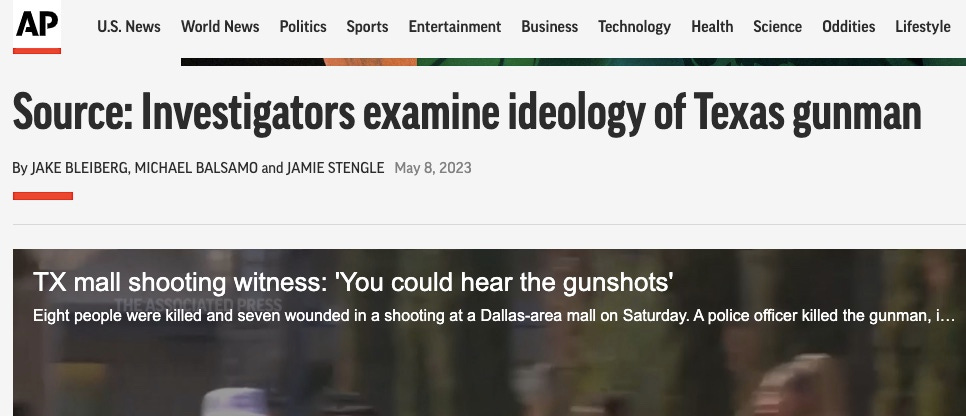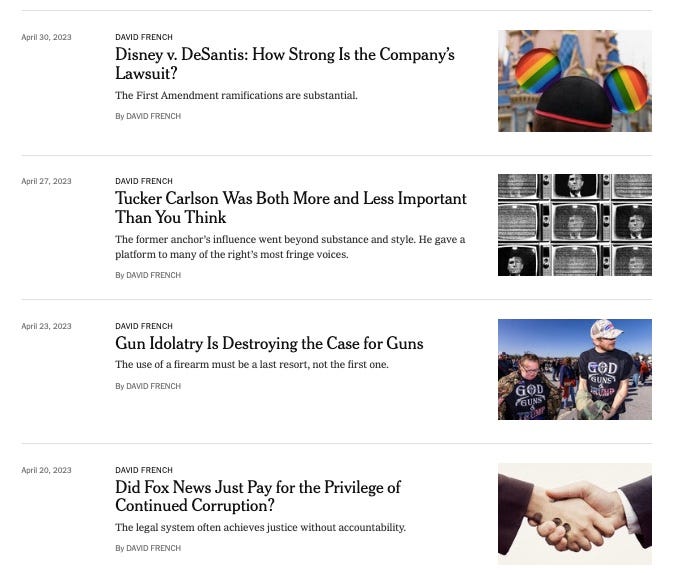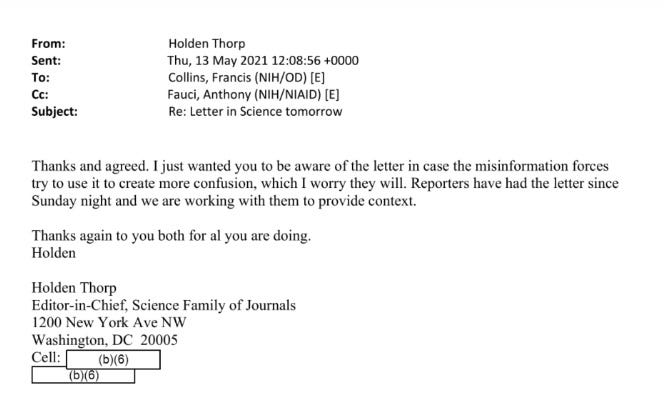Selective Interest
Gun violence continues to bring the most frustrating sort of corporate media hypocrisy
May 14, 2023
Dateline: The day eyes were on Turkey and the results of the election, which appears to be headed to a runoff…
Watching this week…
— Selective ideology and motive gun violence reporting
— French, Tucker, and the value of surprise
— Post-CNN town hall anti-speech activism
— Hypocrisy, disinfo hoaxes - FW Pod with Jacob Siegel
— Great Moments in “Expert”-Spun Science Journalism
Selective Interest: Gun violence brings most frustrating sort of corporate media hypocrisy
Yesterday morning, a white guy was on MSNBC explaining why some Hispanics become white supremacists. “The Latino identity, Hispanic identity, Latinx identity, is incredibly complex,” said Kristopher Goldsmith, who is apparently the CEO of something calling “Task Force Butler,” that I guess has relevance here. “It creates a lot of room for extremist views like white supremacy.”
Goldsmith was teed up by Katie Phang with a question that referenced Proud Boys leader Enrique Tarrio and Nick Fuentes, but the chyron made clear what the real focus was: the person who committed the horrific killing last weekend at the mall in Allen, Texas. During the segment, the Axios headline “Texas mall shooter among growing number of Hispanic white supremacists” from Thursday was shown on the screen.
So here we see the narrative that has been constructed in the wake of the mass shooting in Allen over the course of the past week. The rush to seek a motive was pretty instantaneous. The initial AP article, which was just a news report about the shooting written on May 7, was updated by the next day with a new angle, and new headline — the “ideology” was being examined:
What we found was certainly a person who had some Nazi sympathies — he had a literal swastika tattoo, after all. But even the corporate media reporting on the killer was having trouble finding a specific through line to “white supremacy,” and certainly not to “right-wing extremism.” NBC News examined a variety of the killer’s social media postings, and ultimately had to conclude he had a “mishmash” of disturbing views, that could be seen as anti-woman and anti-Jewish, among others. CNN noted one post that praised the transgender Nashville killer.
Of course, in that mass shooting at the Christian school, we are still in “motive is unclear” territory, largely because the “manifesto” of the killer has been kept from the public — and the press has been extra judicious about not reporting out, or seeking out, any leaks about it. We have word over the weekend the manifesto — a redacted version and the full version — is with a judge for final decision about whether it can be released publicly. So perhaps we are just days away from some further clarity about the killer’s motive in that mass killing from back in March.
The “Hispanic white supremacist” point also took shape because of a second mass killing last weekend in Texas, when a man by the name of George Alvarez drove into a group of migrants in Brownsville at a bus stop, killing eight. The initial report was the man yelled negative comments about the migrants before driving into them — reporting that, thanks to Glance Journalism, fed into a narrative that at least for now seems to be faulty. For one, Alvarez was later reported to have yelled “f-ing migrants”… in Spanish. Although that’s also in dispute. In fact, it’s not clear at this point whether the killing was an intentional act. The driver had cocaine, benzodiazepines and marijuana in his system, and he has a lengthy rap sheet for all sorts of crimes.
Going back to the Allen shooting, regular TV pundit Keith Boykin put out a viral tweet last weekend listing, without context, “mass shootings in Texas,” with Allen being the latest in a long list going back to 2009 and Fort Hood. Not included in Boykin’s list was a 2016 Dallas mass shooting that left five dead — a mass shooting that cost five police officers their lives. It’s a shooting you don’t often hear much about when the corporate press goes through their lists. In that shooting, a Black former army reservist was inspired by the Black Lives Matter protests to “kill white people, especially white officers,” according to the police chief, relaying what the man told police negotiators after the killings.
Surely, he was a crazy person — just like the Allen mall killer. But there wasn’t a lot of “ideology” or “motive” discussion in the corporate press at the time, and like in Boykin’s tweet, it doesn’t fit the preferred narrative.
Meanwhile just as a single isolated case study, I looked into where Boykin is from. It’s not Texas, it’s St. Louis. Hundreds of people in that area have been victims of gun violence in the past year alone, including at least 18 children who died as a result of it in 2022, as laid out in this heartbreaking local news report from January. Not a lot of tweets about that from Boykin, or the broader Acela Media examining the ideology behind these tragic shootings.
And that’s really the point. There’s an endless selective interest in examining gun violence in America. If it doesn’t fit a narrative, it disappears from the headlines. If it can be used to further a talking point about right-wing extremism, expect to see motive as a major storyline on cable news and throughout the media landscape. It’s frustrating, and so transparently hypocritical.
At least 25 people were shot this weekend in Chicago, with at least six dead. Many were teenagers. Will we learn about the motive? How about the ideology? What if we just took the guns away, as so many in the press instinctively urge after a mass shooting like the one in Allen?
Or, a better question — will a single national media outlet even acknowledge it?
David French, Tucker Carlson, and the value of surprise in the media world
Tucker Carlson announced on Tuesday “we’re back,” in a lengthy Twitter video, directing people to an email list at his website and previewing a show which will live on the social media platform… eventually. I have no inside information, but from what I understand from conversations with those in the media, we shouldn’t expect the “show” — whatever it is — to begin any time soon. There’s still the matter of negotiating his exit from Fox News, and while a lawsuit is being threatened by the Tucker side, it doesn’t appear a resolution is coming in the short term.
And that’s too bad — as readers of this newsletter know, I’m a fan of Tucker Carlson, the television host, and the person. I truly think Tucker is one of the most unique and interesting members of the media environment today, and his voice is necessary in our cultural discourse. What separates him from many of his peers is how truly surprising he can be when you tune into his show on any given night — or catch him as an interviewee on a podcast. The value of surprise when it comes to the media is one of the most underrated and important aspects of what gives a media member true power. Love Rachel Maddow or not, but she has a certain way of finding a unique angle into a story, that freshens up what could be a stale topic to a doting audience. She’s surprising, even when she’s not breaking the mold on story selection.
Which brings me to David French. David French is the new “conservative” opinion columnist for the New York Times, who wrote one of the more unfair screeds against Tucker Carlson over these past few weeks. Last Sunday, French’s Tucker column on the former Fox News host’s “dark and malignant influence over the Christian right” delighted readers of the New York Times, and the Twitterati. “For the sake of contestable political issues, he abandoned necessary moral virtues, and he taught his followers to do the same,” concluded French. “His daily example demonstrated that honesty and grace — indispensable qualities in every sphere of life — have no place in the politics of the new religious right, and the new religious right thus repeats ancient sins.”
The column, sadly, could have been written by ChatGPT if I gave it a prompt to spit out a David French column on Tucker Carlson and Christianity. In fact, French’s time in the New York Times opinion pages thus far has mostly been to be the conservative voice criticizing his side, in one capacity or another. Here’s just a brief look at some of his work from a two week period:
DeSantis is bad. Tucker is bad. Gun nuts are bad. Fox News is bad. It’s like a greatest hits of what a New York Times audience would really like to read a “smart conservative” ultimately conclude about his terrible side of the country.
To be fair to French, he does occasionally break the mold, like this push for free speech on college campuses, but even that has to be couched as a “middle ground” approach rather than a full-on defense of conservatism today.
Perhaps this is precisely what the New York Times wants — or, more cynically, demands. But one thing it certainly isn’t is surprising. And it’s boring critiques of Tucker like French’s that make me long for the return of one of the more unique and surprising voices in our cultural conversation.
Media hypocrisy, “disinformation” hoaxes - Fourth Watch Podcast with Jacob Siegel
If you think there’s been a massive uptick in “disinformation” discussions in the media, you’re not alone — and you’re absolutely correct. So what’s behind this: the “disinformation” (and the slightly lesser “misinformation”) rise, but also the rise in counter-”disinformation” efforts?
Jacob Siegel is a senior editor at Tablet magazine, and his excellent, massive 13-part article “A Guide to Understanding the Hoax of the Century” takes on this topic and lays it all out for the reader to comb through and comprehend. And I was glad to have Siegel on the Fourth Watch Podcast this month to discuss what he uncovers — and discuss where this is all going.
In this video clip from the interview, see how January 6 became a key element to the “disinformation” efforts — and using it to empower those who want to crack down on free speech. In a separate lengthy clip, we get deep into understanding why our media and political elite are so obsessed with the counter-"disinformation" efforts. Key reason? “The new effort empowers them. To go against it would require denying self-interest,” Siegel tells me.
Download the full podcast on Apple, on Spotify, or wherever you get your podcasts, where we also get into how he got into journalism and his time in the military, COVID and "disinformation," the backstory of Graphika and how intel agencies work with the media to spin the public, Tucker Carlson's place in the media environment amid critiques of the "ruling class" and Jacob's connection to Tucker's firing, and more.
CNN’s Trump town hall, and the doomed “cover your eyes and ears” strategy of journalism
CNN’s Trump town hall Wednesday night was a huge hit in the ratings. It was pilloried by the #Resistance and the corporate media elite. Interestingly, even those at the network seemed disgusted by the “platforming” of the former president and likely GOP nominee. “It's hard to see how America was served by the spectacle of lies that aired on CNN Wednesday evening,” wrote Oliver Darcy in the Reliable Sources newsletter, to cheers from Kara Swisher and others. Anderson Cooper went on his show Thursday night to deliver an embarrassing apology-like rant to his viewers, who he lamented were likely “anger or upset” to witness the act of journalism.
It’s instructive to internalize this, because it gives a window into the reality about the anti-speech activism in our media. There is an effort among our media elite in the 2016 hangover, where they feel personally guilty about helping to elect Trump, and in the 2020 counter-disinformation wave, to adopt a “cover your eyes and ears” strategy of journalism. This serves no one — not the audience, of course, but also not the journalists themselves, who seem oblivious to the fact that this strategy is antithetical to the core tenets of their occupation. It’s another reason no one trusts them.
I thought Trump was quintessential Trump Wednesday night — very much at home in his element. That was pretty much agreed upon by all corners of the internet. But I also think CNN was well-served by the event, and Kaitlan Collins did about as good a job as moderator as any current CNN employee could have. It was an obviously tough task, but she handled it competently, and while I would have liked the focus of the last half to be reflected in the unnecessary focus on January 6 and election fraud claims in the first half, it did end up making news on several fronts.
But the entire event should be a wake-up call to Chris Licht and the bosses at CNN. I’m all for ombudsmen at CNN, if that’s what Oliver Darcy turns out to be. But the whiny, obsequiousness to the Twitter crowd of Anderson Cooper, and the punditry that clearly is not adapting to this “new normal” on CNN — there are impediments to turning the channel back into the news network of old that remain front and center. Having a town hall with Donald Trump is what every news network should strive to do. Get on board, or go find a non-news network to work for.
WATCH IT… In one of the more bizarre interviews you’ll see this year, Joe Scarborough talks at Sen. John Fetterman throughout a clearly edited 8-minute exchange, mostly consisting of Fetterman giving some brief answers and the MSNBC host going on lengthy rants to serve as prompts for the obviously still ailing senator.
HEAR IT… I did not expect to find Gwyneth Paltrow as down-to-earth as she came across in her “Call Her Daddy” interview, game to get into the details about exes Brad Pitt and Ben Affleck, but also introspective and self-aware about her own life and career.
READ IT… Amy Chozick’s Elizabeth Holmes (ok “Liz”) profile for the New York Times had the media and tech world talking. I found the criticism of it as being PR spin for Holmes over-the-top — like the best writing, it doesn’t beat you over the head with a point of view, and any discerning reader will be able to see through Holmes’ attempts to spin, which are documented not positively but objectively. It’s well worth a read in full.
QUICK HITS
Following the exit of NBCU head Jeff Shell over his inappropriate relationship with her, now CNBC anchor Hadley Gamble is on her way out of the company.
BuzzFeed, then Vice… and now MTV News. Paramount has shuttered the digital outlet as part of overall cuts.
Some people are very mad Politico didn’t win a Pulitzer prize for its leaked Dobbs decision reporting.
Interesting new Substack has launched in beta called FOUND NY, featuring inside details about NYC and surrounding areas.
Laura Coates is out of primetime for CNN, but getting a new gig as “chief legal correspondent” for the network.
Chris Hayes of MSNBC gets profiled for GQ, and we get to learn about what gives him nightmares.
Great Mary Katharine Ham debut for Outkick on the media’s lack of interest in correcting their coverage of the Buffalo Bills punter accused of rape…but now found to be innocent and never charged.
⏪ REWIND // FAST FORWARD: BuzzFeed Edition ⏩
⏪ In September 2016, Politico wrote about the “revenge of the ‘legacy’ sector,” noting how outlets like the New York Times were staving off the rise of BuzzFeed on digital.
⏩ It’s relevant as we say goodbye to BuzzFeed News, now officially shuttered, and BuzzFeed announces a massive revenue decline and a pivot to AI journalism. Rough…
MORE TK…
Remember when we weren’t going to be banning gas stoves? Well New York has, and CNN’s Chief Climate Correspondent Bill Weir says that’s a great thing, because gas stoves are “heating up the planet at sort of a scary rate.” Is that even true? Who knows! I’ll be digging into the climate story in a future newsletter — one of the most important stories our media is covering in an obviously biased and lazy way today.
GREAT MOMENTS IN JOURNALISM
Just one example of a very instructive FOIA dump of emails between Science magazine editor-in-chief Holden Thorp and Dr. Fauci, Dr. Collins and others in the scientific establishment, surfaced by Jimmy Tobias. A great look at the subservience of Thorp to Fauci, and a good show of how our science journalists blew it when it came to COVID coverage.
Thanks for reading. Back soon with a new “Rabbit Hole” column…







How do we, the American public, ever get back to trusting the media? How and where does the voice of middle America get heard and represented? It certainly is not by our elected politicians nor the media. What always seems to be behind the “curtain” is that some larger group is pulling the levers. I hate conspiracy theories but when media vocalizes the same talking points or discredits critics...in harmony there is more going on than independent reporting. Your book points out the problems with media and their coziness with power but I surmise there is more in that black box to reveal!